The Propaganda Campaign to Convince Us Wind Energy Is Still a Good Idea
Big Environment is striving mightily to convince us the catastrophic failure of wind energy in Texas during the Cold Wave of 2021 was trivial or even a good thing. Really. It is a clever, sophisticated effort to deflect from the significant role wind energy had in the crisis.
In order to understand the public relations blitz, please consider this analogy:
Suppose you had an unreliable car that only started two days in winter. You would hate it.
But, suppose a shady organization wanted to sell more of those unreliable cars. They would say, "We only expected the car to start one day a week in winter. The fact it started two days is great. Twice as good as we thought!"
The above analogy is exactly applicable to wind energy's failure in Texas. Consider this quote from The New Republic's reporting on the wind power failure in Texas.
Less important than whether a certain generation source is running at any given point is whether the grid managers expect it to be running.
 |
| Headline from at least two McClatchy papers. The 'expert' quoted is an attorney. The story refers to the Southwest Power Power which does NOT apply to the affected parts of Texas. |
We've seen this "expectation" argument over and over. But, let's look at wind's true performance. Below the arrow is the graph of Monday's Texas wind data direct from the Texas' power manager, a non-profit known as ERCOT. For simplicity, we'll use the word "units" to describe the electrical output of wind energy. If all of the possible wind turbines in Texas (the #1 state for wind energy) were turning and contributing to the grid, the top of the graph would be at 30,000 units.
This graph of wind energy, which came straight from ERCOT and is reproduced full-sized below, starts at 6,500 units at the top of the vertical axis. The actual wind energy is the green line which begins at 5,500 units. As Monday progresses, wind power drops down to just 600 units as of 7pm -- just when temperatures are falling dangerously. That represents 2.3% of wind power's potential. |
| The above from the Wall Street Journal. Their math is off. For example, 4.5 GW of 30 = 15%, not "less than 13%." |
Note the subtle phrasing in the above: "wind only comprises 25% of the state's energy mix this time of year." When the politicians and Big Environment were extolling the virtues of wind energy, did they tell us it was a part time investment?












Comments
Post a Comment